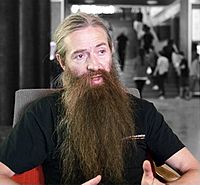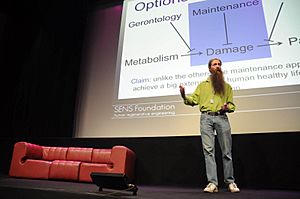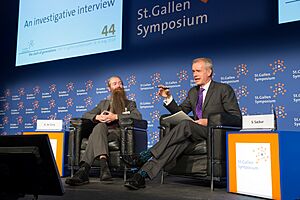Aubrey de Grey facts for kids
Quick facts for kids
Aubrey de Grey
|
|
|---|---|

De Grey in 2018
|
|
| Born |
Aubrey David Nicholas Jasper de Grey
20 April 1963 London, England
|
| Nationality | British |
| Education | Harrow School |
| Alma mater | Trinity Hall, Cambridge (BA, PhD) |
| Occupation | President and CSO of LEVF |
| Known for |
|
| Spouse(s) |
Adelaide Carpenter
(m. 1991; div. 2017) |
Aubrey de Grey (born 20 April 1963) is a British scientist who studies aging. He is known for his idea that new medical technologies might help people alive today live much longer. He believes these technologies could prevent people from dying due to age-related problems. De Grey has also made important contributions to a math problem called the Hadwiger–Nelson problem.
Contents
Early Life and Education
Aubrey de Grey was born in London, England, on April 20, 1963. He grew up in London. His mother, Cordelia, was an artist. She encouraged him to study science and math, subjects she wasn't strong in herself.
De Grey went to Sussex House School and Harrow School. He then studied computer science at Trinity Hall, Cambridge University. He earned his first degree in 1985.
Career Highlights
After finishing university in 1985, de Grey worked as a researcher in artificial intelligence (AI). He also helped start a company focused on checking computer programs.
In the early 1990s, he became interested in the science of aging. He taught himself about biology by reading scientific journals and books. He also attended conferences and learned from Professor Adelaide Carpenter, whom he later married. From 1992 to 2006, he managed software for a genetics database at Cambridge University.
In 2000, Cambridge University gave de Grey a special PhD in biology. This degree was based on his 1999 book, The Mitochondrial Free Radical Theory of Aging. In this book, he explored how damage to tiny parts of cells called mitochondria might affect aging.
Strategies to Fight Aging
By 2005, Aubrey de Grey believed that we already had enough basic scientific knowledge to create effective anti-aging medicines. He felt that the science was ahead of the funding needed to develop these treatments.
De Grey's work focuses on a detailed plan called strategies for engineered negligible senescence (SENS). This plan aims to prevent the physical and mental decline that comes with aging. In 2009, he helped start the SENS Research Foundation. This non-profit group works to develop and share new medical solutions for age-related problems.
Before 2009, de Grey's SENS research was mainly supported by the Methuselah Foundation. This foundation created the Methuselah Mouse Prize. This prize gives money to scientists who can make mice live longer than ever before. De Grey said in 2005 that this prize helps encourage scientists to work on aging.
In 2007, de Grey co-wrote a book called Ending Aging with Michael Rae.
In 2008, de Grey suggested that the first person to live 1,000 years might already be alive. He even thought they could be between 50 and 60 years old at that time.
In 2012, de Grey received a large inheritance. He donated a big part of it, about $13 million, to the SENS Research Foundation.
In 2022, de Grey started the Longevity Escape Velocity Foundation. This foundation supports projects focused on making mice young and healthy again.
Contributions to Mathematics
On April 8, 2018, Aubrey de Grey published a paper that made a big step forward in a math problem. This problem is about how many colors you need to color a certain type of graph. His work increased the lowest number of colors needed from four to five. This was the first progress on this problem in over 60 years.
Xenocatabolism Concept
De Grey also introduced a concept called xenocatabolism. This idea involves putting special enzymes from microbes into the body. These enzymes would help break down harmful substances that build up in our cells as we age. He thought that microbes found in places like graveyards might have these abilities. He suggested that we could use genes from these microbes to help our bodies clean themselves better.
Views on the Future
Future of Anti-Aging Medicine
Aubrey de Grey believes that medical technology could allow people alive today to avoid dying from age-related causes.
He created the term Methuselarity. This refers to a point in time when medical treatments will be so good that they can keep people healthy. As new and better treatments come out, people would continue to live healthily indefinitely. He calls this "longevity escape velocity." In 2022, he said there was a 50% chance this breakthrough could happen in about 15 years.
De Grey thinks that many people have a "pro-aging trance." This means they accept aging as unavoidable, which he sees as a barrier to developing anti-aging medicine quickly.
Technology Review Debate
In 2005, a magazine called MIT Technology Review offered a prize. They wanted to see if any scientist could prove that de Grey's SENS ideas were "so wrong that it is unworthy of learned debate." The judges decided that no one could completely disprove SENS. However, they also noted that SENS's supporters had not fully proven their case. They concluded that many of SENS's ideas could not be tested with the science and technology available at that time.
Later in 2005, the MIT Technology Review published an article that was critical of de Grey. It suggested his theories might oversimplify the goal of anti-aging.
EMBO Reports
In 2005, an article in EMBO Reports by 28 scientists discussed SENS. They pointed out that none of de Grey's specific ideas had yet been shown to make any organism live longer. The SENS Research Foundation agreed with this, stating that reversing aging damage "right now... you can't." However, de Grey argued that this showed a misunderstanding between basic scientists and those working on regenerative medicine.
Many scientists on the SENS Research Foundation's advisory board have supported the SENS approach. In 2021, the National Institute on Aging (NIA) in the U.S. even highlighted a SENS research project and provided funding for it.
Future of Work
Aubrey de Grey believes that automation will eventually take over most jobs. He thinks that a universal basic income will be needed. This would be a way to share wealth without people having to work jobs they might not want to do.
Cryonics Views
De Grey is a cryonicist. This means he believes in the idea of preserving a body at very low temperatures after death. The hope is that future technology could revive and heal the person. He thinks it's a "tragedy" that more people don't understand or support cryonics. He believes more research into cryopreservation could give more people a chance at life.
See also
 In Spanish: Aubrey de Grey para niños
In Spanish: Aubrey de Grey para niños
- List of life extension topics
- Regenerative medicine



